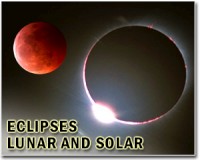 |
Washington DC (SPX) Jul 20, 2009 Save the date Aug. 1, 2008, to watch a total eclipse of the sun. NASA Television will share this stunning visual treat with observers around the world in a live streaming webcast, thanks to a partnership with the University of California at Berkeley and the Exploratorium. On August 1, a total solar eclipse will be visible in parts of Canada, northern Greenland, the Arctic, central Russia, Mongolia, and China. The eclipse will sweep across Earth in a narrow path that begins in Canada's northern province of Nunavut and ends in northern China's Silk Road region at sunset. Watch NASA TV's streaming live webcast of the event from 6 a.m. (EST) until 11 a.m. (EST). The eclipse coverage is part of the Sun-Earth Day celebration, an annual event that strives to share the many ways in which the sun interacts with Earth and the other planets in our solar system. An eclipse of the sun occurs when the moon passes directly between Earth and the sun. When the moon's shadow falls on Earth, people within that shadow see the moon block a portion of the sun's light. The moon's shadow has two parts, an umbra and a penumbra. The umbra is the "inner" part of the moon's shadow. The penumbra is the moon's faint "outer" shadow. During a total solar eclipse, like the one that takes place August 1, the moon appears to cover all of the sun for observers located in the moon's umbral shadow, also known as the "path of totality." Those viewing the eclipse from the moon's penumbral shadow see the moon cover a portion of the sun. At the moment of totality, when the sun is totally obscured by the moon's shadow, the sun's outer atmosphere, called the solar corona, becomes visible. It's a seldom-seen sight coveted by experienced eclipse watchers and an awe-inspiring vision for first-time viewers. The solar corona extends farther than 620,000 miles from the sun's visible surface and reaches temperatures up to 2 million degrees. Be sure to catch the event August 1 on NASA TV's streaming live webcast and celebrate this magnificent sight, courtesy of our nearest neighbors, the sun and moon. Share This Article With Planet Earth
Related Links NASA TV Solar and Lunar Eclipses at Skynightly
 Solar eclipse sparks tourism fever in China
Solar eclipse sparks tourism fever in ChinaShanghai (AFP) July 16, 2009 The longest total solar eclipse of the 21st century, visible next Wednesday, has sparked tourist fever in eastern China, which according to experts is the best place to view the event. The total eclipse, expected to last about six minutes, will pass from southwest China across the cities of Chengdu and Chongqing to Shanghai and Hangzhou in eastern Zhejiang province, according to NASA's eclip ... read more |
|
| The content herein, unless otherwise known to be public domain, are Copyright 1995-2009 - SpaceDaily. AFP and UPI Wire Stories are copyright Agence France-Presse and United Press International. ESA Portal Reports are copyright European Space Agency. All NASA sourced material is public domain. Additional copyrights may apply in whole or part to other bona fide parties. Advertising does not imply endorsement,agreement or approval of any opinions, statements or information provided by SpaceDaily on any Web page published or hosted by SpaceDaily. Privacy Statement |